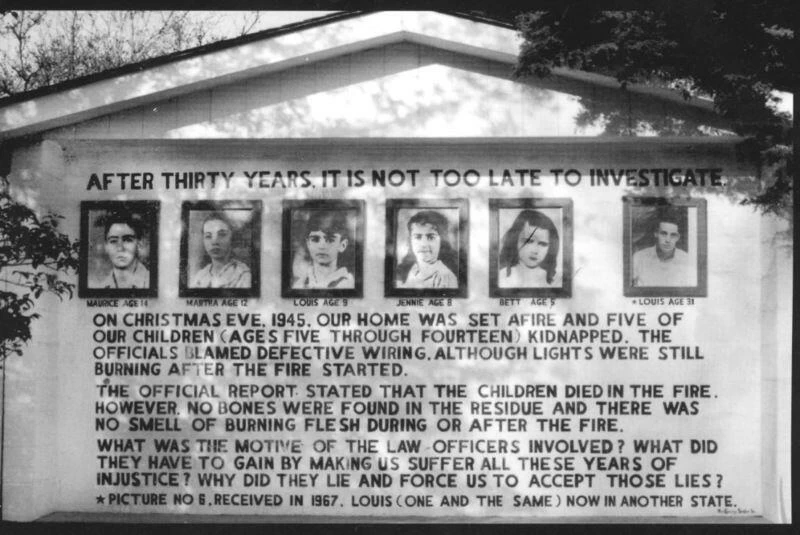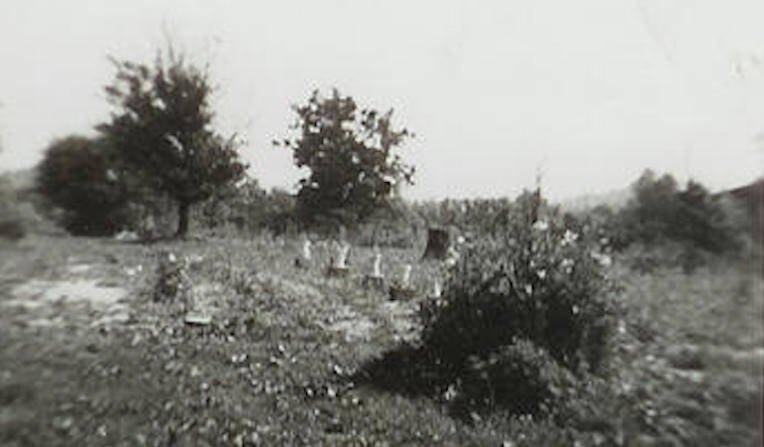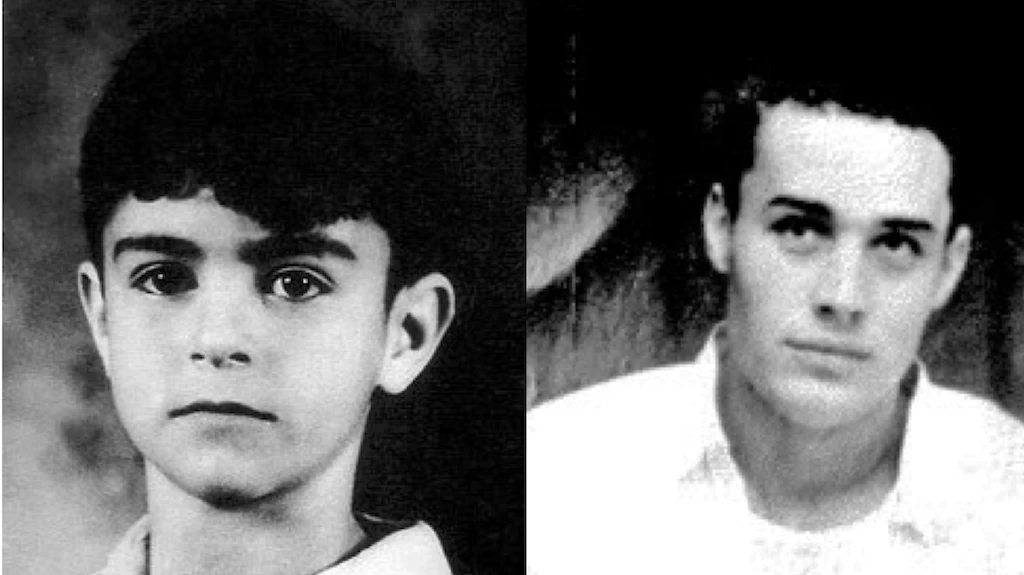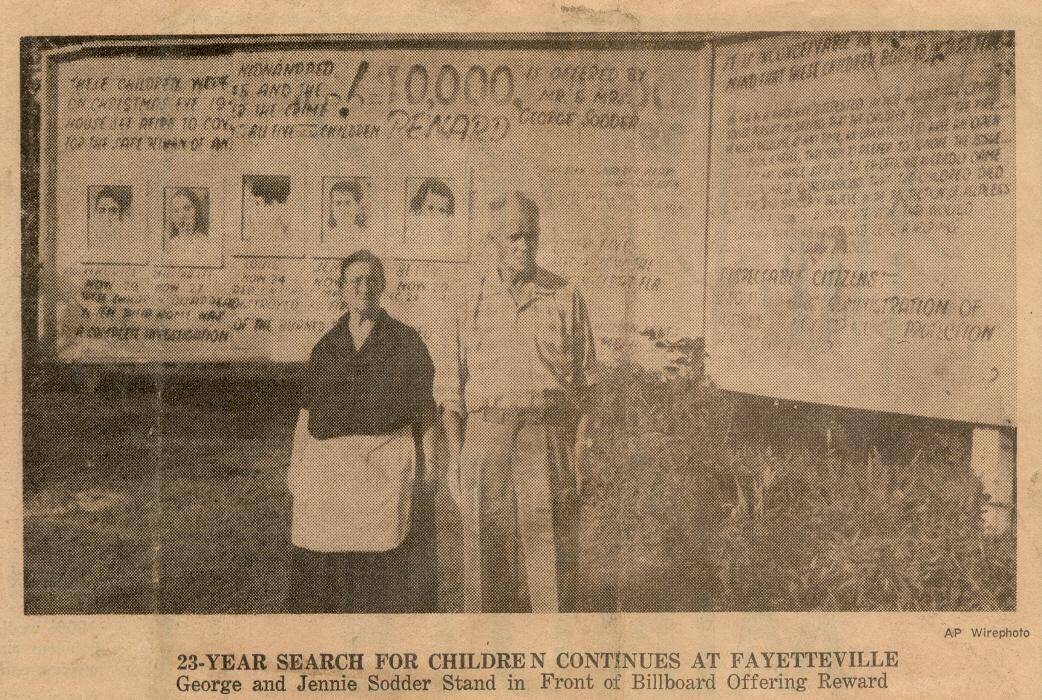On Christmas Day 1945 in the Appalachians, a devastating fire broke out at the residence of George and Jennie Sodder at around 1:00 am. Four of the ten Sodder children survived, one had been away fighting the war, but the other five disappeared from the house the night of the incident. Not a trace of any of their remains turned up in the aftermath. Although authorities ruled the cause as “faulty wiring,” mysterious occurrences in the days and hours leading up to the disaster, plus evidence of sabotage at the Sodder house, suggest something far more sinister than an accidental house fire.
[blockquote align=”none” author=”Jennie Sodder”]You can’t tell me five children could burn up in a little old house like that and something wouldn’t be left. No, I’ll never believe it. Somebody stole them, that’s what. It’s been a long time but maybe I’ll be lucky enough to see them someday.[/blockquote]

Ages and Names of the Sodder Children
Members of the Sodder family who survived the fire were George and Jennie Sodder, parents; John, 23; George Jr., 16; Marion, 17; Slyvia, 3. Joseph or “Joe,” 21, was away in the Army.
The five children who disappeared were Maurice, 14; Martha 12; Louis 9; Jennie 8; Betty 5.
George Sodder and His Antifascist Views
The small coal-mining town of Fayetteville, West Virginia, was home to a thriving Italian-American population. Most of the community knew the Sodders as a respectable, upstanding family. George Sodder (originally Giorgio Soddu) had immigrated from Sardinia in 1908 and, then at the age of 50, owned a truck-hauling business.
World War II had just ended on December 2, 1945. Only eight months prior, communist partisans had killed fascist dictator Benito Mussolini, which left the Italians highly divided. Supporters of Mussolini were outraged. George was politically outspoken and held strong antifascist views about Mussolini. Consequently, he had engendered bitter distrust amongst those of his fellow Italian immigrants who had loved the Italian leader.
Unexpected Visits to the Sodder Home
In the months leading up to the fire, a few strange encounters took place. First, an unknown man approached George Sodder at his home looking for work. After George told him he didn’t need any workers, the man looked up at the fuse box outside and said, “This is going to cause a fire someday.” The remark seemed odd since George recently had the power supply company check the electrical wires, and all checked out fine.
Another notable visit took place at the Sodder house just weeks before the fire. A local salesman tried to sell life insurance to them. Upon George’s refusal, the exasperated salesman threatened, “Your goddamn house is going up in smoke, and your children are going to be destroyed. You are going to be paid for the dirty remarks you have been making about Mussolini.”
Also just before Christmas, the older Sodder boys saw a suspicious car parked along Highway 21 for a few days in a row. A man inside the car was watching the Sodder children closely as they returned from school.
Christmas
The night before Christmas was frigidly cold. Jennie and George Sodder were ready to turn in for the evening with 3-year-old Sylvia at about 10:30 pm. The oldest girl, Marion Sodder, had brought home some toys from the dime-store where she worked and gave them to the younger Sodder kids. Jennie allowed them to stay up later than usual to play with their new gifts. But she reminded the boys, Maurice and Louis, that, before they go to bed, they needed to shut the chicken coop and feed the cows.
Related: Disappearance of the Beaumont Children
About midnight, a phone call forced Jennie awake. When she answered, a woman asked for an unknown name. Jennie would later recall that the woman had a “weird laugh,” and others were also laughing and clinking glasses in the background. Jennie told the woman she had the wrong number and didn’t think much about it.
At that time, the house was all quiet. Marion was asleep on the couch, and Jennie noticed that the doors were unlocked, and the curtains were still open. Typically, the children take care to secure the house before they turn in for bed, but for some reason, not on this night. Jennie locked up and closed the shades, assuming that the rest of the children had gone to sleep in the attic. She then retreated to bed.
The Sodder Fire Breaks Out
About a half-hour passed. Jennie woke when, as she later described, “Something hit the roof — like a rubber ball. It rolled and hit the ground with a thump.” However, she didn’t pay much attention to it and went back to sleep. Another half-hour passed, and this time she awoke to the smell of smoke. George, Jennie, the baby, Marion, John, and George got out. Unfortunately, the staircase to the attic had begun to fill up with fire. Oddly, when the Sodders yelled up to the attic, they heard no response from the younger children, as Jennie explained:
“I ran to the bottom of the stairs where the children were supposed to be sleeping. I yelled and yelled, and two boys (John and George Jr.) came stumbling down. Their hair was singed by the flames.”
Suspicious Circumstances at the Scene
Perhaps the most suspicious part of the story lies in George Sodder’s attempts to rescue his children as his house went up in flames. Sodder recalled that there was a ladder permanently leaning on the side of his house for regular maintenance, such as cleaning the gutter and fixing the roof. George’s first idea was to get to the children using this ladder. However, according to reports from the night of the fire, the ladder wasn’t where it should have been. Unbeknownst to them at the time, it was lying in a road-side ditch away from the house.
Meanwhile, Marion tried to call the fire department, but the phone didn’t work. She had to run to a neighbor’s house to call, and even then, an operator was not available. Eventually, a good samaritan got in touch with the fire station from a phone in town.
George’s second effort to reenter the burning house was to drive his work trucks to the side and climb over the top of them to the upper window. But when he tried to start them, George discovered that neither of the trucks would start.
While the Sodder family faced one misfortune after another, their house burned to the ground in only 45 minutes.

Findings After the Fire
Firefighters did not appear until around 7 am. By then, all that remained was rubble and the hot ashes. The search for the children lasted until 11 am, but nothing turned up. The state police deemed that the blaze started due to faulty wiring but later withdrew their statement. Then Fayetteville Fire Chief FJ Morris conducted a thorough investigation and found nothing to contradict the ruling of ‘faulty wires’ nor any evidence of bodies.
Charles Payne from the funeral home went to the site the next day to collect the bodies, but he found no remains. Years later, Payne’s wife Velma commented, “It seems to be a mystery” in the Beckley Post-Herald newspaper.
Several days after the blaze, the coroner put together an inquest consisting of a jury that would determine the cause of the fire. Interestingly, one of the jury members was the man who told George that his children would be destroyed and his house would burn down. Not surprisingly, the jury also ruled that faulty wiring caused the fire.
However, the Sodders did not agree. It occurred to them that the house lights remained on for some time as they watched their home burn down. Jennie later commented that they could not have found their way out of the house without the lights on. Additionally, George had replaced the old wiring to install a new electric stove. The facts didn’t add up, and the Sodders were questioning the ‘faulty wiring’ explanation.
Witnesses of Suspicious Events
Several other discoveries cast more doubt in the Sodders’ minds. A telephone repairman informed them that someone had cut the phone lines. That could be the reason why Marion couldn’t phone out: not because the lines had burned.
Neighbors saw a man stealing a block and tackle at the Sodders place while the fire was raging. Police later arrested him, and he admitted that he climbed up and cut the wires. The man said he thought he had snipped the electrical cables, but it appears that he cut the phone wires instead. No one seems to know what came of this arrest or why police didn’t follow it up.
You May Also Like: What Happened to Bobby Dunbar?: A Bizarre Story of Two Vanishings
Another witness, a bus driver who worked the late shift, said that he saw “balls of fire” landing on the roof. By now, the circumstances were pointing toward arson. Then came the witnesses who said they saw the Sodder children.
Sodder Children Sightings
The following reports of sightings emerged:
- A girl claimed to have seen the children in a car that was driving away as the fire raged.
- Someone working in a motel about 50 miles outside Fayetteville claimed to have seen the children the day after the blaze.
- At a Charleston hotel, a woman reported seeing the kids check-in along with two women and two men of Italian heritage. Her account goes, “The children were accompanied by two women and two men, all of Italian extraction. I tried to talk to the children in a friendly manner, but the men appeared hostile and refused to allow me to talk to these children. One of the men looked at me in a hostile manner; he turned around and began talking rapidly in Italian.”
- A missionary saw a picture of the children in the paper and claimed that he saw the children in a house in Cortez, Florida. A private detective who investigated this lead said that they were definitely there but were gone. Apparently, five different people had seen them in Cortez.
Jennie Sodder’s Search for Clues
Unsatisfied with the conclusion of the investigation, Jennie Sodder began searching for answers. She experimented with animal bones in her wood stove, trying the best she could to get them to burn down. She was unable to reduce them to ashes.
When Jennie read about another house fire in the newspaper that burned the house down and killed seven family members, she knew she was on to something. Investigators had recovered the remains of all seven bodies in the rubble.
You May Also Like: The Kidnapping of Charley Ross
Frustrated with the lack of answers from the authorities in the Sodder case, she reached out to a crematorium worker. He certified that even bodies burned at 2,000 degrees for two hours leave charred bones. At the Ground Zero site after the September 11 attacks, human remains survived the jet fuel fires. It is utterly implausible that an electrical fire which lasted for 45 minutes would leave appliances but no trace of the children at the Sodder’s place.
Private Investigator C.C. Tinsley
George and Jennie hired a private investigator named C.C. Tinsley, who could help with the Sodder children’s disappearance. He heard that Fire Chief Morris told some folks that he had found a heart at the scene and buried it in a dynamite box. The detective contacted Morris and convinced the Chief to show it to him and George. Together, they went to the site and dug it up.
Tinsley took the organ to a funeral director, who determined that it was a chunk of beef liver. George also sent the liver to Washington for testing, and the document returned confirming it was beef liver. However, the organ had never been in a fire, which indicates that Morris had placed it there sometime later. Rumors circulated that Morris had admitted to a few folks that he staged the organ in the rubble to pacify the Sodders and to get them to stop investigating. Evidently, the authorities wanted them to believe the children had perished in the fire.
Other Clues in the Sodder Children’s Disappearance
Three months following the Sodder disaster, Sylvia was playing around the rubble while the Sodders visited their former home. She found a hollow green object made of hard rubber. It had a twist cap. Sylvia wondered if that could have been the object that hit the roof. George took the strange item to military officials. They told him it was an incendiary “pineapple,” more commonly known as a napalm bomb.
You May Also Like: California’s Unsolved Keddie Cabin Murders of 1981
In 1949, George and Jennie hired a pathologist from Washington D.C., Dr. Oscar B. Hunter, Jr. A few days after the fire, George Sodder had covered the basement remains with several feet of dirt, because he planned to turn the site into a memorial for the children.
During Hunter’s excavation of the site, some human vertebral bones surfaced. He sent them for analysis at the Smithsonian Institution. Researchers determined that the age of the bones was inconsistent with the ages of the Sodder children. Additionally, the bones showed no signs of charring. “The bones, the report concluded, were most likely in the supply of dirt George used to fill in the basement to create the memorial for his children” (Abbott, 2012).
Was Louis Sodder Found?
In 1968, the Sodders received a letter in the mail containing a photo of a grown-up young man who resembled Louis Sodder. The postmark was from Kentucky, but there was no return address. Inside, there was also a message: “Louis Sodder. I love brother Frankie. Ilil boys. A91032 or 35.” With such a cryptic note, this was perhaps a cruel prank. Still, it was another strange twist in the tale. Over the two decades following the fire, George and Jennie Sodder would receive leads in the form of photos or anecdotes from people who claim to have heard information about the incident. However, none of these proved reliable and only further obscured the story.

In 1952, George and Jennie had erected a large billboard on Route 16 with pictures of the missing Sodder children and a reward for $10,000. They maintained the board for 37 years. In the end, they had spent more than $15,000 (more than $200,000 today) on a slew of private investigators and travel expenses across the country during their search.

Revenge on George Sodder?
Despite the official determination that the five youngest Sodders died in an electrical fire, the evidence alludes to a sinister criminal conspiracy. Everyone was aware that several members of the Fayetteville Italian community had grievances with George Sodder. Uninvited visitors to their home foreshadowed what would happen on Christmas Day.
Possibly, the late-night phone call was to ensure that Jennie and George were awake to survive the impending fire. Also, it surely cannot be a coincidence that the missing children were the ones who stayed up late to play. The most logical conclusion is that people hostile to George Sodder wanted him to suffer a painful lesson for the rest of his life. In other words, the circumstances scream foul play. To this day, one prevailing theory involves the Italian mafia.
Today, Sylvia Sodder Praxton is the only member of the family still alive. Her parents hoped that the story and memory of the Sodder children could remain alive, and Sylvia has faithfully organized a memorial meeting in Fayetteville every year. Sylvia will be 77 this year. George Sodder died in 1969 at the age of 73. Jennie Sodder passed away in 1989. She was 85 and continued to grow flowers at the site where the children disappeared. The Sodder parents vowed to search for their children until their deaths — and they did.
References:
Abbott, Karen. “The Children Who Went Up In Smoke.” Smithsonian.com. Smithsonian Institution, December 25, 2012.
Douthat, Strat. “Five Faded Photographs in Fayette.” Beckley Post-Herald, The Raleigh Register. Newspapers.com, May 18, 1975.
Jackson, Niles. “What Really Happened to Children?” Roots Web, December 22, 1968.
Jolly, Nathan. “Baffling Christmas Mystery: What Happened to the Sodder Children?” NewsComAu. news.com.au, December 25, 2018.
Roper, Matt. “Mystery of 5 Children ‘Killed’ in House Fire – but Their Bodies Were Never Found.” mirror, April 12, 2019.
Sorensen, Rachel. “Entry 10: The Sodder Children.” UNFREEZING COLD CASES, December 1, 2019.